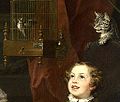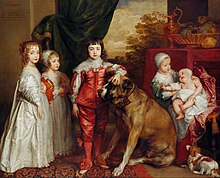
Sir Joshua Reynolds was an English painter who specialised in portraits. John Russell said he was one of the major European painters of the 18th century. He promoted the "Grand Style" in painting, which depended on idealisation of the imperfect. He was a founder and first president of the Royal Academy of Arts and was knighted by George III in 1769.
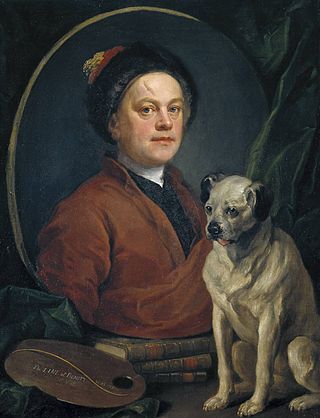
William Hogarth was an English painter, engraver, pictorial satirist, social critic, editorial cartoonist and occasional writer on art. His work ranges from realistic portraiture to comic strip-like series of pictures called "modern moral subjects", and he is perhaps best known for his series A Harlot's Progress, A Rake's Progress and Marriage A-la-Mode. Knowledge of his work is so pervasive that satirical political illustrations in this style are often referred to as "Hogarthian".

English art is the body of visual arts made in England. England has Europe's earliest and northernmost ice-age cave art. Prehistoric art in England largely corresponds with art made elsewhere in contemporary Britain, but early medieval Anglo-Saxon art saw the development of a distinctly English style, and English art continued thereafter to have a distinct character. English art made after the formation in 1707 of the Kingdom of Great Britain may be regarded in most respects simultaneously as art of the United Kingdom.
A Rake's Progress is a series of eight paintings by 18th-century English artist William Hogarth. The canvases were produced in 1732–1734, then engraved in 1734 and published in print form in 1735. The series shows the decline and fall of Tom Rakewell, the spendthrift son and heir of a rich merchant, who comes to London, wastes all his money on luxurious living, prostitution and gambling, and as a consequence is imprisoned in the Fleet Prison and ultimately Bethlem Hospital (Bedlam). The original paintings are in the collection of Sir John Soane's Museum in London, where they are normally on display for a short period each day.
Joseph Grozer (1755–1799) was an English artist and printmaker. He resided at No 8, Castle Street, Leicester Square (1792-4) and published some of his prints himself.
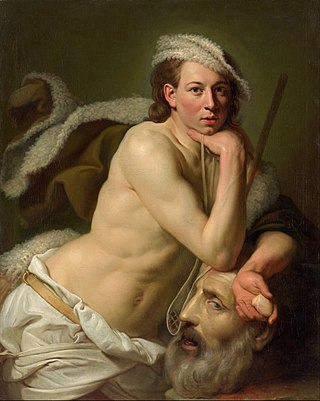
Johan Joseph Zoffany was a German neoclassical painter who was active mainly in England, Italy and India. His works appear in many prominent British collections, including the National Gallery, the Tate Gallery and the Royal Collection, as well as institutions in continental Europe, India, the United States and Australia. His name is sometimes spelled Zoffani or Zauffelij.
Martin Postle is a British art historian who is deputy director for collections and publications at the Paul Mellon Centre for Studies in British Art, London, and a leading expert on the art of Sir Joshua Reynolds. He is a former curator at the Tate Gallery.
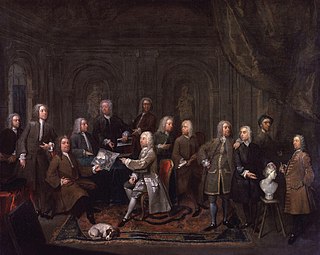
Gawen Hamilton, easily confused with the later, more prominent artist Gavin Hamilton, was a Scottish painter working in London, a member of the Rose and Crown Club. He was one of the first wave of British born painters of 'conversation pieces' along with contemporaries such as William Hogarth and Charles Philips. These are works that depict groups of friends, families and acquaintances often engaging in a variety of genteel activities such as playing cards or taking tea. Some of Hamilton's pieces depict gatherings of artists and craftsmen such as the Rose and Crown Club itself.

Philippe Mercier was an artist of French Huguenot descent from the German realm of Brandenburg-Prussia, usually defined to French school. Active in England for most of his working life, Mercier is considered one of the first practitioners of the Rococo style, and is credited with influencing a new generation of 18th-century English artists.
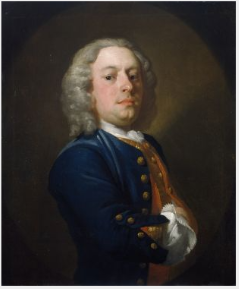
James Latham was an Irish portrait painter.

Thomas Gibson was an English portrait painter and copyist, notable as the teacher of George Vertue. He was born and died in London.

The Age of Innocence is an oil-on-canvas painting by Sir Joshua Reynolds, created in either 1785 or 1788 and measuring 765 x 638 mm. The sitter is unknown, but possibly, was Reynolds's great-niece, Theophila Gwatkin, or Lady Anne Spencer (1773–1865), the youngest daughter of the 4th Duke of Marlborough, who would have been twelve in 1785 and fifteen in 1788. The painting was presented to the National Gallery in 1847 by Robert Vernon and has hung in the Tate Britain since 1951.
Balthazar or Balthasar Nebot, was a painter active in England between 1729 and 1765.

Daniel Graham was apothecary to King George II, King George III and Chelsea College Hospital. He was the son of Thomas Graham who was apothecary to King George I and George II, and was apothecary general to the British army.

Richard Robert Graham was apothecary to the Chelsea College Hospital. He was the son of Daniel Graham who was apothecary to King George I and George II, and was apothecary general to the British army.
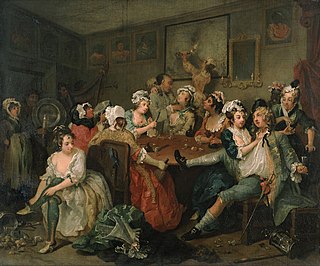
Tavern Scene or The Orgy is a work by William Hogarth from 1735, the third picture from the series A Rake's Progress.
Judith Emilie Egerton was an Australian-born British art historian and curator. She specialised in eighteenth-century British art and, particularly, the work of George Stubbs.

Trump was a pug owned by English painter William Hogarth. He included the dog in several works, including his 1745 self-portrait Painter and his Pug, held by the Tate Gallery. In the words of the Tate's display caption, "Hogarth's pug dog, Trump, serves as an emblem of the artist's own pugnacious character."

Frances, Baroness Byron, was the second daughter of William Berkeley, 4th Baron Berkeley of Stratton, and his wife Frances Temple. She was the third wife of William Byron, 4th Baron Byron and a great-grandmother of the poet Lord Byron.



